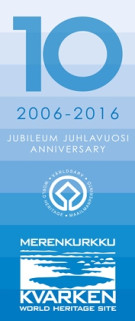Granösund Museum safeguards traditional islander culture
The World Heritage Site is about more than the uplift of the land; it also includes the cultural traditions of the archipelago. The Granösund Museum in Södra Vallgrund displays the culture of the islanders in a time when sealing and fishing were the primary sources of livelihood in the area.
The World Heritage Site is about more than the uplift of the land; it also includes the cultural traditions of the archipelago. The Granösund Museum in Södra Vallgrund displays the culture of the islanders in a time when sealing and fishing were the primary sources of livelihood in the area.
Guide Anders Myntti and the chairperson of the home district association Replots Skärgårds Hembydgsförening, Ulrika Vestergård-Denward, want to bring the history of the archipelago alive. Old articles, such as the ice skates Myntti is holding, remind us of a time when sealing and fishing were the main sources of livelihood here.
The World Heritage Site is about more than the uplift of the land; it also includes the cultural traditions of the archipelago. The Granösund Museum in Södra Vallgrund displays the culture of the islanders in a time when sealing and fishing were the primary sources of livelihood in the area.
The Granösund Museum includes thirteen buildings, the oldest of which date back to the late 18th century. The aim of the museum is to bring history alive so that visitors don’t just look at items but actually experience the everyday tasks of islanders, such as rope making and knot tying.
“We have a lot of activities, especially for children. You can try your hand at handling a spinning rod, for example, or identify fish species and estimate their speed and maximum weight,” says guide Anders Myntti.
“For groups, we organise activities such as grilling fish in a gridiron or smoking it,” he continues.
Can you identify the fish species in the picture? Can you also guess how much they weigh?
“You find peace here”
The museum houses, for example, a boat from 1864, each side of which is built from just three broad rough-sawn planks.
“Large trees were required to build boats like this, and when there were no more trees that were large enough, boat building stopped. The boat on display at our museum is extremely well preserved. You could probably still sail in it, but we're not going to try,” Myntti laughs.
The culturally and historically valuable museum buildings have been transported here from elsewhere in the archipelago. The museum opened for the public in 1972, is run by volunteers and its activities are directed by the home district association Replots Skärgårds Hembydgsförening. Ulrika Vestergård-Denward, the association’s chairperson, applauds the museum’s atmosphere.
“When you come here you find peace and nothing to disturb you. The historic surroundings inspire many of our elderly visitors to tell stories about their youth, which is very rewarding for guides too," Vestergård-Denward says.
The boat from 1864 is extremely well preserved. Each side of it is built from just three broad rough-sawn planks.
Photo exhibition and crafts evenings
The museum is open from the 28th of June to the 6th of August from Wednesday to Sunday. Groups, such a schools or companies, are also welcome at other times by appointment. The museum had about a thousand visitors in 2015 and 2016.
“As a guide, I’m delighted to receive positive feedback from our customers," Myntti says.
“Often our visitors are surprised by how much there is to see here,” Vestergård-Denward continues.
The Granösund Museum includes thirteen buildings, the oldest of which date back to the late 18th century.
The Granösund Museum will open an exhibition about the work of marine pilots on 8th of July. In July, the museum also holds crafts evenings, with knitting, photo developing and making your own shampoo, etc. Vestergård-Denward is very pleased to see old crafts skills being passed down and new things being created using old traditions.
“When you learn about your past you get to know your own roots better. When you realise how things used to be done in the archipelago, you begin to pay attention to how you do things today. I want to keep this place alive and help to retain our traditional islander culture,” Vestergård-Denward explains.
Text and photographs: VASEK
Translation: Taina Pemberton
 The Kvarken archipelago is the only World Natural Heritage Site in Finland listed in the UNESCO World Heritage List. The archipelago is rising from the sea in a process of glacio-isostatic uplift in which the land that used to be weighed down by the glacier during the last Ice Age continues to lift today. Nowhere in the world is this uplift better displayed than in the Kvarken, and at rates that are among the highest in the world. Consequently, you can see unique glacial formations in the Kvarken archipelago, such as De Geer moraines and ribbed moraines, which make the scenery so exceptional and varied.
The Kvarken archipelago is the only World Natural Heritage Site in Finland listed in the UNESCO World Heritage List. The archipelago is rising from the sea in a process of glacio-isostatic uplift in which the land that used to be weighed down by the glacier during the last Ice Age continues to lift today. Nowhere in the world is this uplift better displayed than in the Kvarken, and at rates that are among the highest in the world. Consequently, you can see unique glacial formations in the Kvarken archipelago, such as De Geer moraines and ribbed moraines, which make the scenery so exceptional and varied.
For more information go to: http://www.kvarkenworldheritage.fi/experience-kvarken/
Read the other articles about the Kvarken archipelago:
Molpehällorna island, Cruise to the Mickelsörarna, Sommaröhallen crafts shop, Aava Kerttu homestead, Merenkurkun Majatalo inn, Kvarkenturer, Café Salteriet & Villa Meribjörkö.